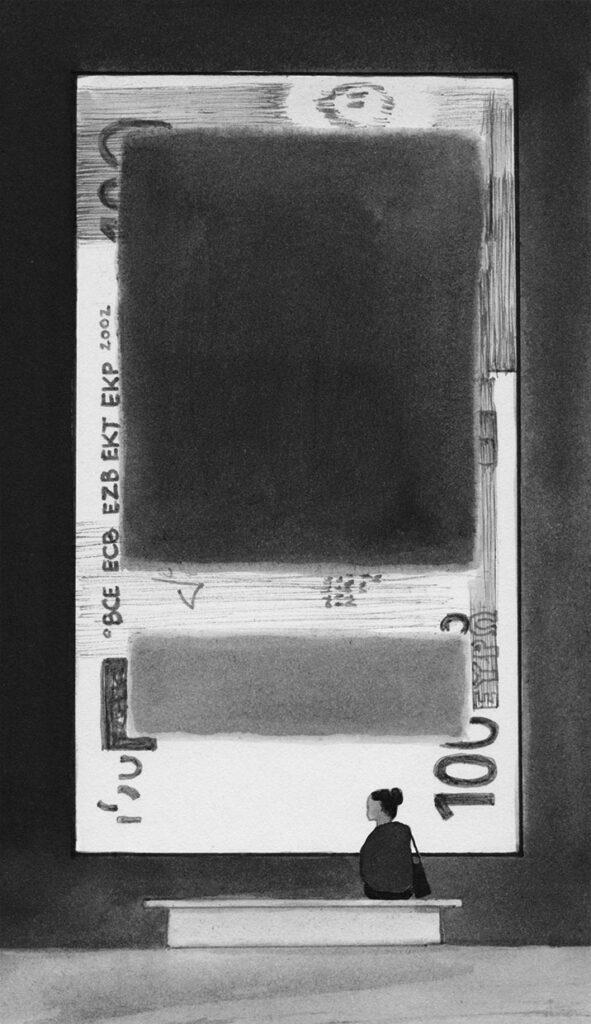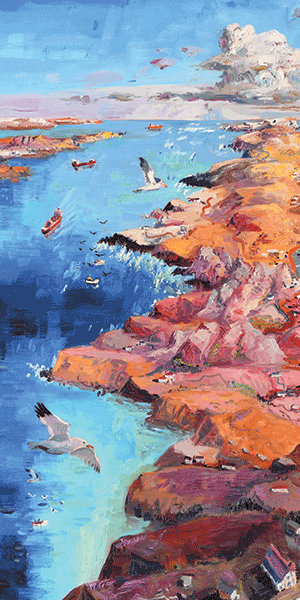Exhibiting such a broad, thorough, and representative set of works is the fulfillment of a long-standing personal wish.
— Bernard Arnault
Something happens to artists at a certain point — when their work starts selling above an unearthly, somewhat ephemeral line. The individual works themselves cease to be genius (or middling, experimental, or fully realized). They become instead the products of a genius, all equally brilliant and — at least according to the dealers and brokers and art‑world hype teams that write catalogues and appreciations — equally valuable.
I was thinking about just that this past spring, while walking through the Fondation Louis Vuitton on the outskirts of Paris. The art museum and cultural centre, the personal legacy project of Louis Vuitton Moët Hennessy’s founder and CEO, Bernard Arnault, looks a little like a spaceship docked in a public garden; it’s all insectoid folds and gleaming panels. Opened in 2014 at a cost of more than $1 billion — underwritten, controversially, with public tax credits — the Frank Gehry design sits in the Bois de Boulogne across the river from Nanterre, as far from the heart of the art establishment as you can be in Paris and still be in Paris at all.
Last fall, the foundation launched the largest retrospective of works by the American painter Mark Rothko ever held outside the United States, and the largest curated anywhere in a generation. With 115 paintings spread across the entire museum, the show spanned the full breadth of Rothko’s career. It covered his earliest, figurative work, his surrealist phase, and the gauzy, colourful rectangles that made him famous and are today synonymous with his name.

Pondering the show and sell of modern art.
Silas Kaufman
The show was the realization of an ambitious dream for Arnault, one of the richest men alive, according to Forbes, and a very public Rothko superfan. There is no little irony here. The artist himself was famously derisive of the rich. He pulled his largest-ever commission — a $35,000 (U.S.) mural series for the Seagram Building in midtown Manhattan — after having dinner in the Four Seasons restaurant, where the paintings were supposed to hang. “Anybody who will eat that kind of food for those kinds of prices will never look at a painting of mine!” he told his studio assistant.
But such is the reality of the art world in the twenty-first century. As Harry Bellet, the veteran art critic for Le Monde, told me in Paris, no public gallery in France could have considered such a bold retrospective. The insurance costs alone would have blown even the Louvre’s mammoth budget. Add in the costs of transporting that many massive, delicate works (Rothko often painted with experimental and, it turns out, quite fragile pigments) and the horse-trading involved in convincing museums major and minor from all over the world (plus some of the wealthiest collectors alive) to part with their best Rothkos at the same time, and you have some idea of why only a person of Arnault’s means and influence could pull it off.
It’s often hard not to be cynical about the relationship between fine art and money. Rothko himself was reasonably well off by the time he died, by suicide, in 1970, but he was never rich. Today, you would have to be not just rich but ultra-rich to buy one of his works. Bob Mnuchin, who made a fortune at Goldman Sachs (and whose son Steve was Donald Trump’s treasury secretary), owns the painting that inspired the Seagram commission. Kenneth Griffin, the mega-billionaire founder of Citadel Securities and a major Trump backer, recently bought Rothko’s No. 6 (Violet, Green and Red) from a Russian oligarch for more than $100 million (U.S).
At the same time, there is still the art — and the fact that without someone like Arnault, it wouldn’t be on view, all together for the first and quite possibly last time.
I had flown to Paris days after covering a preliminary hearing for Trump’s criminal trial for falsifying business records to pay off a pornographic film star. While I was in New York, a container ship the length of three football fields crashed into the Francis Scott Key Bridge outside Baltimore, killing six men and collapsing most of the 2.6-kilometre crossing. Seventy-two hours before standing in front of some of the most enduring artworks of the twentieth century, I was ankle-deep in Maryland’s Patapsco River, staring through the pouring rain at destruction on a scale my brain had trouble comprehending. The sheer size of the bridge and the ship that had hit it scrambled something in me. I felt cold, not just physically but internally somehow, for days.
I mention that feeling here only because it serves as a useful antithesis to what I felt, three days later, in the best rooms at the Rothko show. The retrospective, like much of Rothko’s career, was mixed. His earliest work is generally forgettable; it’s interesting mostly for the hints it offers about the artist who would later emerge. For all their history and hype, I found the Seagram murals, huge panels usually on display at the Tate Modern, in London, lifeless and inert. But the best stuff, the later stuff, stunned me.
There is so much money to be made by selling the idea that every Rothko is brilliant simply because it is a Rothko. The accidental genius of the Paris show is that it proved the opposite is true. Rothko produced many fine paintings, some okay stuff, and, at his absolute peak, a collection of truly transcendent works. I spent more than eight hours at the show, spread over two days, much of it in a single room on the sixth floor filled with paintings from the 1960s. There were several works in that room — including No. 1, Red and White, 1962, now back on display at the Art Gallery of Ontario, in Toronto, and No. 14, 1960, from the San Francisco Museum of Modern Art — that stand with the finest paintings I have ever seen.
The latter work, a near square of about nine feet by nine feet, has a massive blazing orange haze over a smaller, fuzzy-edged purple one. As in most great Rothkos, the best places in it are the ones where the colours merge. They evoke oceans and clouds and uncertainty, impermanence, and what happens when you reach out and fail and reach again.
I was in Paris on the last day of the Rothko retrospective. As the show inched closer to its end, I realized I would almost certainly never see its like again. There are only so many Arnaults willing to spend so much of their own money, social capital, and time on something so large and so public. I don’t know that I left the Fondation Louis Vuitton with any more clarity on my feelings about the intermingling of the ultra-wealthy and the art world. But I do know that, in that moment, I was grateful.
Richard Warnica is a reporter and editor with the Toronto Star.

